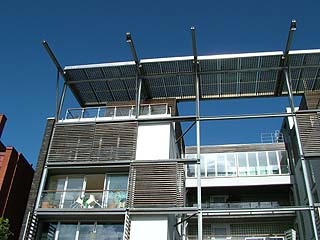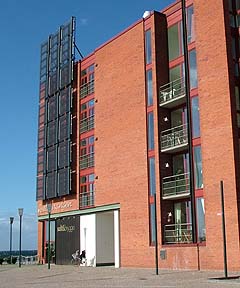|
Subscribe / Renew |
|
|
Contact Us |
|
| ► Subscribe to our Free Weekly Newsletter | |
| home | Welcome, sign in or click here to subscribe. | login |
Architecture & Engineering
| |
February 16, 2005
Green buildings a start, but can we think bigger?
GGLO

Photos by Denise Fong, Candela
Solar PV panels supplied and operated by the local energy utility are installed on these private housing units in Malmö, Sweden. |
By now you have likely read several articles about the trips to Scandinavia led by International Sustainable Solutions. You may have marveled at what has been accomplished there, but you may have also wondered what it means for you here in the United States.
After all, sustainable design is driven by local context. Does any of that cool stuff really apply here in the Puget Sound area?
I am actively involved in sustainability with four LEED projects under my belt, and I wondered that as well. So last fall, I made the trek with about 20 other architects, engineers, contractors, developers and Diane Sugimura, director of the Seattle DPD and the first public servant to go on the trip.
I expected to see a broader application of the same ideas we use in the US and that proved to be true. There is wider acceptance of green building practices that are still considered cutting-edge here, like wind power and green roofs.
However, what surprised and inspired me was the emphasis not only on sustainable buildings, but also on the systems and infrastructure that support them.
Think regionally
In the U.S. most of us only consider sustainability within the context of our particular building and site. In Scandinavia, major systems have been dealt with in a regional way. Even in the green-friendly Puget Sound region, we have not even begun to address sustainability at a regional level.
So what would it take?
Deb Guenther's article about stormwater systems showed how a developed site can maintain some of the ecological function it had as a greenfield by collecting water from roofs and directing it into ponds. In addition to obvious environmental and aesthetic benefits, this approach puts much less demand on public infrastructure.
Jim Duncan's article on wind power described how political and grassroots measures have made Denmark a net exporter of energy and renewable energy technology, and the world's leading manufacturer of wind turbine technology.
Scandinavia shows it is possible to use incentives to benefit both the public and private sectors. Why not here?
Cost vs. benefits
The barrier to these obvious win-win solutions lies in a disconnect between cost and benefit. The developer is asked to bear initial costs and the burden of proof for innovative technologies, while the public reaps the benefit of strategies that reduce demand and extend the life of existing infrastructure systems.
Imagine what innovations could occur if private efforts to reduce demand could be matched by public sector incentives.
Public/private partnerships could take many forms. Seattle City Light has been very proactive in reducing demand for electricity by offering incentives to developers to build energy efficient buildings. By doing so, they have delayed construction of new power plants by decades.

Vertically mounted thermal solar panels on this building provide heating and feed into the district energy system that delivers heat throughout the city of Malmö.
|
A more systemic approach could mean no new power plants for generations to come. Consider what the mobile phone companies have done to get coverage for their services. They pay an owner for the right to put antennas on his land or building.
What if Seattle City Light could follow their example and approach power the same way? What if a building owner gave Seattle City Light the right to install vertical axis wind turbines or photovoltaic panels on their roof? The utility would own and maintain the equipment and charge for the power, and it would be creating distributed renewable power sources throughout the region.
Puget Sound Energy could put solar panels on buildings to supplement the hot water system. In conjunction with a centralized system to deliver hot water on demand, individual furnaces and water heaters could be eliminated, reducing space needs and capital costs.
This benefit can be compelling for developers who measure cost by rentable square footage. All the stakeholders would enjoy more effective delivery, less reliance on non-renewable energy sources, and a more secure energy system protected against market fluctuations. In addition to reduced reliance on fossil fuel, we would be reducing green house gases in the region.
Political differences
| The ISS tours |
|
In 2004, International Sustainable Solutions brought several groups of architects, engineers, developers and others from the Pacific Northwest to Scandinavia to look at advanced urban sustainability projects. During these trips they visited Copenhagen, Denmark and Malmö, Sweden. ISS is accepting applications for the next Urban Sustainability Study Group to Sweden and Denmark, in May 2005. For information see www.i-sustain.com/. ISS encourages the sharing of knowledge and the creation of market opportunities for sustainability practices and products. |
I haven't even mentioned the highly coordinated and efficient transportation and waste management systems.
In Copenhagen, disincentives associated with cars and parking are matched by traffic measures that encourage bicycles and multimodal travel and pedestrian-friendly squares.
In Sweden, 50 landfills in 14 municipalities have been reduced to four through the formation of a public utility to cooperatively manage waste -- including food waste, which is composted and sold. Retired landfills become usable land, usually recreation areas.
These regional approaches to infrastructure needs are prime example of incentives, public/private partnerships, and a view that creates a whole greater than the sum of the parts.
Obviously, our political system is different from Scandinavia, where the majority of these investments in the common good are funded by the 50 percent value-added tax that the average Scandinavian pays. But should that mean that we cannot accomplish what we think is better for the community and the future?
South Lake Union
Our current thinking that sustainability is accomplished by individual developers on a building-by-building basis is very limiting and does not offer the range of return on investment that we should be demanding.
What if we considered some of these broader perspectives as we contemplate the development of a new region like South Lake Union, with aging infrastructure and a burgeoning population? What if private developers who committed to no net increase in storm-water runoff on their South Lake Union projects were met by reduced public infrastructure requirements or other incentives? What if the transportation system for the neighborhood favored pedestrian, bicycles and public transportation instead of cars? What if a centralized food waste compost system was implemented?
As the Scandinavia tours and the many articles and presentations reflect, I am not the only person thinking about this. Private interests and public sector concerns do overlap and can be aligned through incentives, regulations, and innovative approaches like those discussed above. Public/private partnerships could be the key to creating the foundation for a sustainable future.
Nancy Henderson is a senior associate and co-chairs GGLO's Sustainable Design Group. She went on the October 2004 study tour of Malmö, Sweden, and Copenhagen, Demark, with International Sustainable Solutions.


